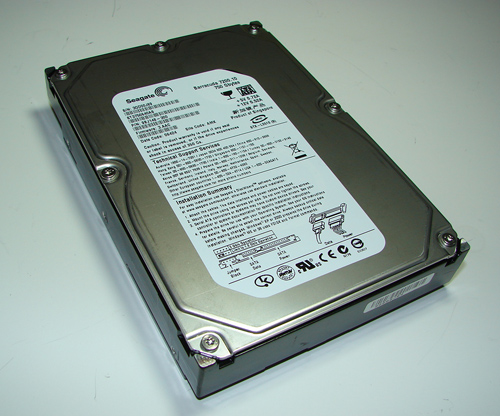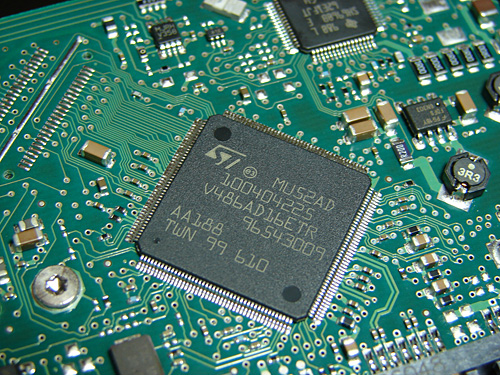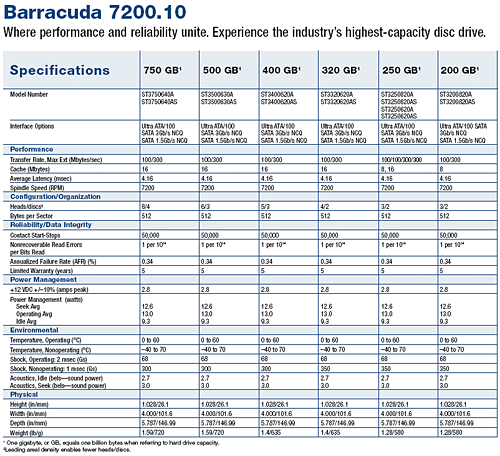Seagate Barracuda 7200.10 750GB: Size Does Matter
by Gary Key on May 18, 2006 9:00 AM EST- Posted in
- Storage
Feature Set and Options

The external casing design of the Seagate Barracuda 7200.10 series is basically unchanged from the previous generation 7200.9 series. The drive is based on the industry standard 3.5" form factor platform with pertinent part number and warranty information embossed on a white sticker on the top of the casing. However boring the exterior design maybe, lurking under the plain casing is an impressive 750 GB storage capacity that did not require a new form factor or additional platters. Based upon the potential of perpendicular technology, this same casing could be holding two terabytes of capacity in a relatively short time.

The 7200.10 SATA family ships with the Serial ATA data and power connectors only. There is no longer support for the 4-pin Molex power connector designed for use with older ATX power supplies. To the left of the data and power connectors is a four pin jumper block. This jumper block will determine whether the drive operates in Serial ATA/150 or Serial ATAII/300 mode. Two pins are enabled by default, meaning the Seagate Barracuda 7200.10 ships and will operate in SATA/150 mode. In order for the drive to operate in Serial ATAII/300 mode, the jumper must be removed. Enabling SATAII/300 is recommended if you have a compatible motherboard that fully supports SATA II/300 operations. While this feature was advantageous for burst transfer rates in our synthetic benchmarks, overall we did not see any real improvement in our real world benchmarks.

The PCB is openly visible on the bottom of the drive as in previous series and now contains an ST Micro controller chip. The ST Micro Serial ATA controller chipset is a departure for Seagate as they have previously used an Agere chipset. Our recently delivered Seagate 7200.9 500GB test unit is also employing the ST Micro chipset, so it appears this is a change for both drive series at this time. The 16 MB of cache memory is located on the opposite side of the PCB.
 |
| Click to enlarge |
Seagate currently has 14 variations of the 7200.10 product series planned for release over the next few weeks, with select drives also being offered in the external Pushbutton Back-up Hard Drive line in late May or early June. The entire lineup features perpendicular recording technology with our review unit being the new high capacity model at 750GB. This is the industry's highest offered capacity in a single disk drive and is made possible by four 188GB platters spinning at 7200 RPM with a 16-megabyte buffer size.
Seagate is also introducing two new technologies in the 7200.10 products. The first is Adaptive Fly Height, and it maximizes the consistency of read/write performance across the entire disc by adjusting the fly height (distance between the disc head and platter) according to changes in environmental operating conditions. The second is Clean Sweep that assists in maintaining media integrity and drive reliability by passing the drive head over the entire platter during power-on to smooth out any irregularities in the disc surface.
Capacities for the 7200.10 series range from 200GB to 750GB with PATA, SATA 1.5Gb/s, and SATA 3.0Gb/s interfaces being offered. The 200GB and base 250GB models feature an 8MB buffer while the 250GB, 320GB, 400GB, 500GB, and 750GB models will have 16MB buffers. Seagate has dropped the MTBF (mean time between failures) measurement and switched to a percentage based Annualized Failure Rate (AFR) measurement which is estimated to be 0.34%.
A complete price list has not been published; however, Seagate says the 200GB model will retail at US $105 with the 750GB model currently offered for around US $500. Product launch has already occurred with the 750GB being widely available at online retailers, and the balance of the product line is expected within the next couple of weeks and at the brick and mortar outlets in late June.










44 Comments
View All Comments
Larso - Monday, May 22, 2006 - link
Well, you usually plot dB on a linear axis, taken for granted that the interpreter knows the exponential nature of decibels (+10 dB sounds like doubling the loudness). But since our ears/brain also interpret sound levels in an exponential fashion, its not _that_ misleading...
If you really want to show the soundlevel in a linear fashion, you would have to measure loudness in http://en.wikipedia.org/wiki/Sone">Sone
- Gary: Sorry if I've missed it, when you measured the loudness, was the drive secured to the case with screws, or was it suspended softly? It would be interesting to know how much of the noise was due to vibration, and how much was actual noise emission from the drive.
Perhaps some kind of soft suspension would make the drive noise more bearable, subjectively?
Gary Key - Thursday, May 25, 2006 - link
The drives are suspended via soft rubber bushings in the drive cage in order to equalize the test results between drives (as much as possible). This drive will create an additional low pitch vibration when attached directly but nothing like the sound a Raptor produces when attached directly, subjective opinion of course. :)
TonyB - Thursday, May 18, 2006 - link
how soon till we see 1TB hard drive. 7200.11?Gary Key - Thursday, May 18, 2006 - link
We should see a 960GB drive by Q4. We will see the 1TB+ drives in 2007, maybe earlier depending on how well the new 200GB plus platters test out. Also, if Hitachi or WD press Seagate on the issue in Q4 I am sure it be out early. ;->Zaitsev - Thursday, May 18, 2006 - link
Page 4 reads, "we decided the make the switch at this time as the performance."I enjoyed the article, Gary.
"I would much rather show the benefits of RAID 5, 0+1, 10 in a separate article"
I think that's a great idea, and am looking forward to it.
Gary Key - Thursday, May 18, 2006 - link
The link highlight on the word "applications" right before "we" is hiding the semi-colon somewhat. I will see if we can edit the hyperlink to correct this. :)
Thanks for the comments. We are trying to head in a more technical direction in the storage section. We have some additional audio/video tests coming along with application timer benchmarks that should lighten up the presentation. Also, we did not report WB99, IPEAK Access, Disk Bench, IOMeter, or other benchmarks yet, still gauging what information is valuable, interesting, and required.
JarredWalton - Thursday, May 18, 2006 - link
Actually, he was referring to the word "the" - fixed now, as it should have been "to". :)Zaitsev - Thursday, May 18, 2006 - link
Sorry about that. I will be more clear next time. :)Gary Key - Thursday, May 18, 2006 - link
I will wear my glasses next time.... LOL
peternelson - Thursday, May 18, 2006 - link
Hi,
I can understand why you want to test sound levels as close as 5mm.
However, to someone quickly looking at the results charts without carefully reading the text they might think your db(A)@5mm are comparable with db(A) measurements taken at more conventional distances like 1 metre away.
To avoid such errors being made when comparing BETWEEN reviews, please clearly label the audio charts not just "db" but "db(A)@5mm"